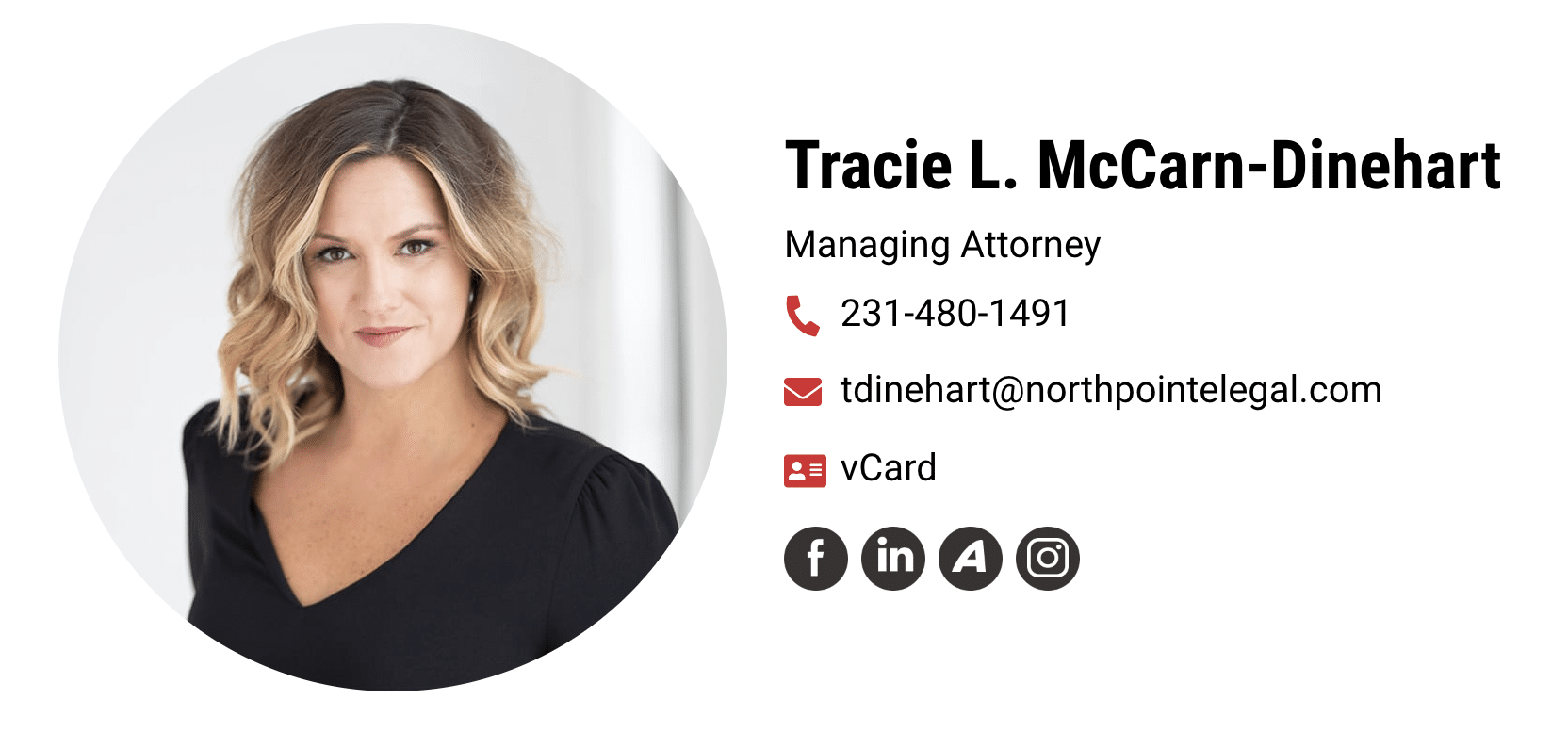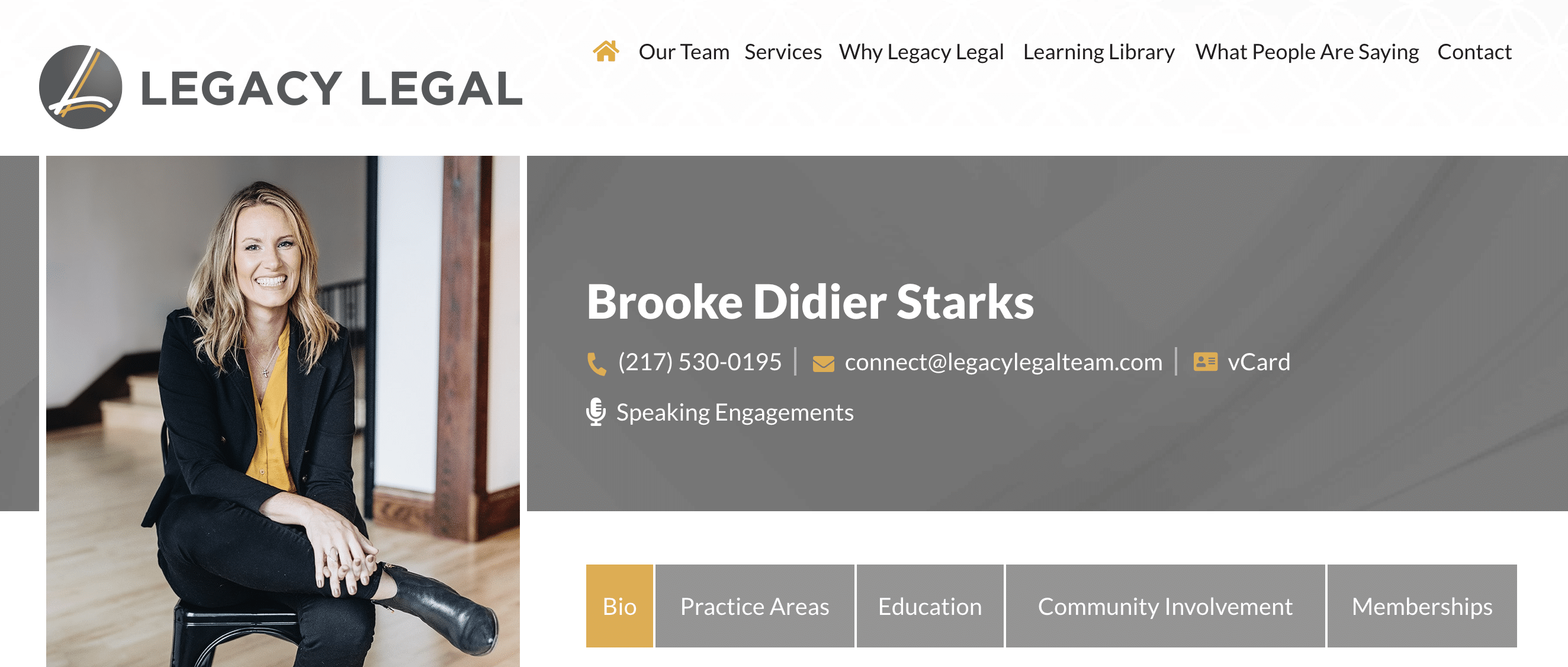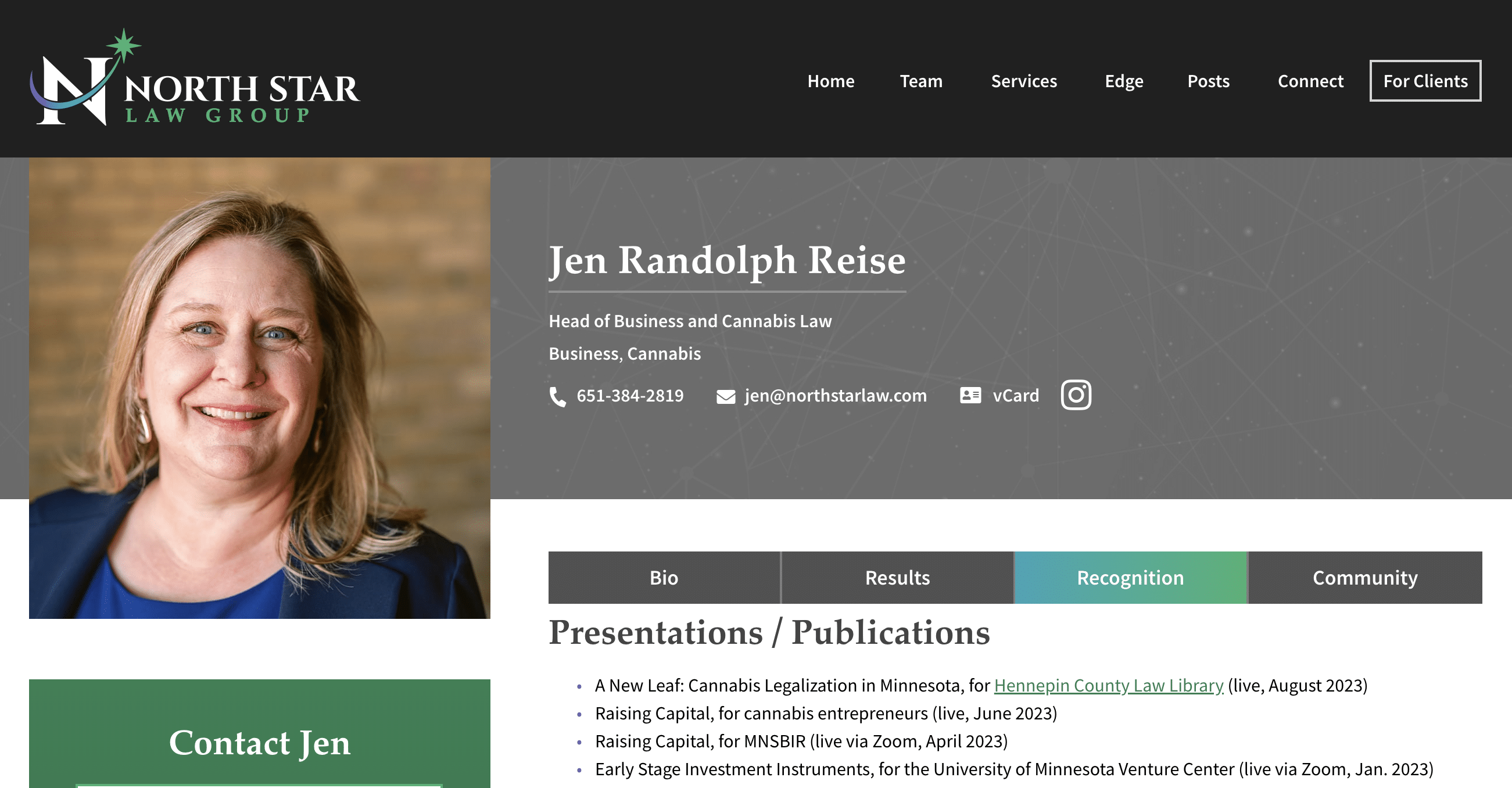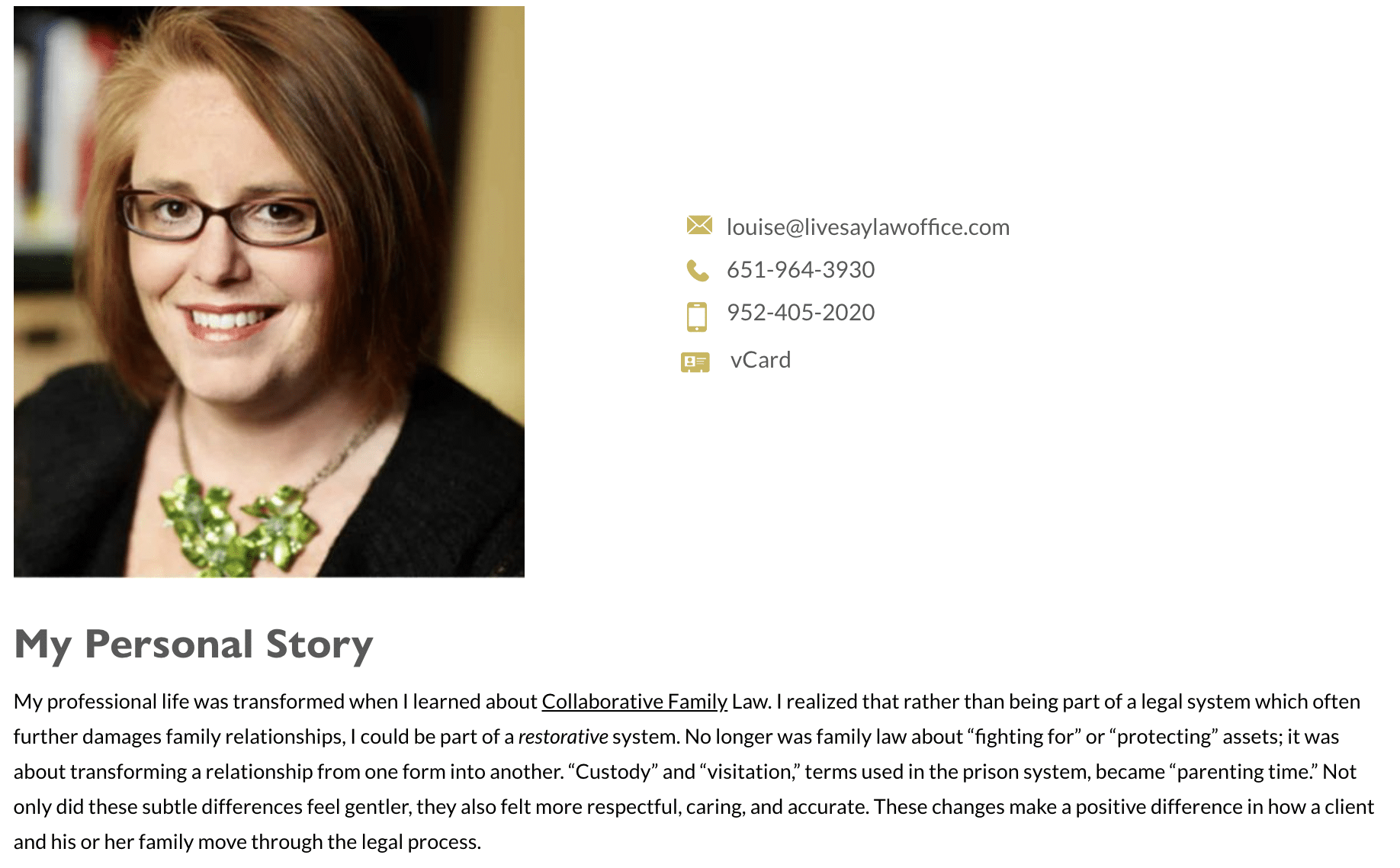Menu
September 8th, 2023
The data is clear: attorney biographies are one of the most important pages on a law firm's website. Second to the homepage, bios are the most frequently viewed and tend to have the highest conversion rate for website users to become potential clients. Nevertheless, most lawyers put far more work into their practice area pages than their bios, and we’re here to tell you that they both deserve the same attention.
Practice area pages describe your services for potential clients and signal to search engines how you can help people. But that's exactly it — you're offering a service, not a mere product. Behind every service is a person. And that person makes all the difference when it comes to referral and client relationships.
Whether your practice is referral-based or may depend on traffic from Google search results for local attorneys, a potential client hearing your name or landing on your website is just the first step. Viewing your attorney biography is likely the next step and it may be the difference in losing that client or convincing them to pick up the phone.
How Do You Create the Best Attorney Profile Possible?
Your Website Profile Photo is More Important Than You Think
A professional relationship is like any other personal relationship that hinges on trust: people need to be able to put a face to your name and credentials.
YES you need to have a photo on your biography. NO you do not need to lose 20 pounds or look like a fashion model. And YES, the photo needs to be professionally taken (or at least look like it was; with a little practice and care, most nicer smartphones can now take portraits that will work).
For more specific advice on attorney profile photos, check out these previous blog posts:
- Does My Law Firm Website Really Need My Picture?
- Secrets to Great Business Headshots
- DIY Headshots for Attorneys
Make It Easy for Potential Clients to Contact You
Phone Number, Email Address and V-Card
The Modern Firm is often asked whether attorneys should share their email addresses or direct phone lines on their websites. They often cite concerns about spam emails or, in the case of v-cards, skepticism about whether their prospective clients can easily download them. Our advice is to absolutely make sure a website visitor can contact you directly from your profile. Exactly how you do that might vary.
- Phone number: Include a phone number and make sure it is formatted for one-click dialing from a mobile device or smartphone. Whether it's your main line or your direct line is up to you. If you use a main line, make sure that line is answered when you're not in — ideally by a live person. Phone numbers on web pages can also be formatted for one-click texting. We’ve heard from attorneys in some practice areas who’ve found that, among their clientele, texting is much preferred to email or a voice call.
- Email: Include your email address for easy contact. With regard to spam, our company line is: better to upgrade your email spam filter than to potentially lose clients who would prefer to directly email you. Spam filters are constantly improving. If you elect not to give out your direct email address (either because you prefer an uncluttered inbox or because you won't be the one triaging new contacts), that’s fine. Instead use your firm's general email address.
- V-card: We do recommend that you include a v-card, which is like a downloadable digital business card, even though they aren’t widely recognized outside of business circles. Some potential clients love them. Those who don't use them just ignore them. That said, if you have a primarily consumer practice you might be right that very few of your prospects would make use of a v-card. In that case, we won't argue too much if you want to leave it off!
- Social media: If you have an active profile on Facebook, LinkedIn, Twitter, or TikTok you should be including a link from your website to your social media account. It's no secret that social media is a popular channels for potential clients to learn more about you and your practice. But, just as importantly social linking builds authority with Google and other search engines. So, it's a win for you and a win for your clients when you include a social media link on your attorney bio.
Additional Tips to Help Your Write Your Website Bio
Bottom line: the primary, if not sole, purpose of your website profile is to encourage prospective clients to get in touch. Make it as easy as possible for them to communicate with you using their preferred method!
Your Website Biography Isn't (Only) About You!
Don't make the common mistake of assuming your website bio is about you. Really, it's about your clients.
When you meet someone for the first time, you don’t want to hear a list of their accomplishments and achievements; you want a little glimpse into the story of their life.
The profile pic may be a client’s first impression of you, but the bio itself is that first conversation.
What does that potential client need to know about you in order to determine whether or not you’re the right person to help them with their problem?
You certainly need to touch on your professional background, select accomplishments, and your approach to the practice of law. But think about all these things from the perspective of what a potential client is looking for in an attorney. Some clients may be looking for sympathy, reassurance, or assertiveness. Others may be seeking evidence that you've had numerous successes in the type of matter they're facing. Corporate clients may be evaluating whether your personality will mesh well with the in-house team you'd be working with. Savvy local clients may be wondering if you've appeared before particular judges.
- For consumer-focused practices — like family law, estate planning, personal injury, bankruptcy, etc. — emphasize what you can do for a client and what you're like to work with. Be personable. Assure them that, in addition to your being competent in your field, you have worked with folks just like them and they will be comfortable working with you.
- For practices with professional clientele — where you are hired by organizations, particularly sophisticated parties, and even other attorneys — the emphasis is more on your background and accomplishments. But this doesn't mean your personality shouldn't come through. For some client bases, this might even mean communicating your sense of humor and college sports preferences. For others, you may wish to share your philosophy or approach to law, offer pertinent personal details, and otherwise set yourself apart from your immediate competitors.
In either case, lead with what you do for clients and reasons why you’re good at it, rather than just writing a chronological history of your background. Here are a few examples of well-executed attorney profiles that follow the above advice, ranging from more to less touchy-feely:
- Ann Arbor, Michigan probate attorney Suzanne Fanning
- Maryland family law attorney Geoffrey Platnick
- Chicago Personal Injury Attorney Tony S. Kalogerakos
How Long Should Your Biography Be?
To simply answer the questions, 4-6 sections is a great length for an attorney bio.
On one hand, your website profile is not meant to be your curriculum vitae. A website profile is meant to catch the eye, spark interest, and confirm some central features of your background and current work. CVs can be important — and you certainly can link to your CV from your web profile. But the two items serve different purposes. Your web profile should be easily digestible and give a sense of what it’s like to work with you.
On the other hand, if one goal of your website is search engine optimization (SEO), size matters in a different way. In order to increase your firm's visibility to search engines, and thus land you closer to the top of the results page for local attorneys who practice particular types of law, you need to capture their attention. Search engines demand a decent amount of content to sink their virtual teeth into, so you shouldn't make your narrative too short.
Bottom line: if yours is primarily a referral-based practice — and your website is largely a "validation" site for folks checking you out after hearing your name elsewhere — aim for two to six paragraphs of five or fewer sentences each. If you are aiming to market yourself online via organic search results, however, try for an overall length (including your bulleted lists, addressed below) of more than 500 words.
Keep a lengthier narrative digestible with short paragraphs and SEO-friendly, skimmable headings. Here’s a couple of examples of bios that use this strategy:
- Anacortes, Washington criminal defense attorney Justin Campbell
- Plano, Texas intellectual property and commercial litigation attorney Steven Malin
Should You Use Bulleted Lists of Résumé Items?
Generally, yes: we like bulleted lists displaying your educational history, practice areas, professional associations, etc. for several reasons:
- They lend legitimacy by calling attention to important details of your work and background.
- By creating a place for these easily summarized professional items, you can avoid having to spend time recounting dry lists of facts in your bio and instead focus on painting a more vivid narrative.
- They make the page more interesting visually — and avoid overly-long, eye-glazing walls of text — whether the lists come after the narrative or appear in their own section of the biography page, such as in the margin.
- For sites aimed at SEO, where the overall biography must be longer, they add length and meaningful detail without making the narrative imposingly long.
Categories to Include in Your Attorney Bio
Education
Include where you received your law degree, undergraduate degree, and any other relevant postgraduate degrees or certifications. Include details that would be meaningful to your particular clients. Avoid details that make your mom proud but aren't necessary for your clients, like the number of semesters you made the Dean's List in undergrad or how your moot court brief won an award 25 years ago.
Most attorneys include the years they received each degree unless they want to avoid drawing too much attention to their ages (whether because they're more vibrant than their years suggest or because they entered the field of law very recently). Either way, list the most recent degree first.
Bar & Court Admissions
Most attorneys also include state bars to which they are admitted along with relevant federal or specialty courts. The most common exception is for locally-based consumer-oriented practitioners who are simply admitted in the single state where they practice.
Practice Areas
For larger firms with a number of practice groups, individual attorneys nearly always list their particular areas of practice. In this case, we recommend that you use the exact title used on the website's list of practice areas and link to the relevant practice area pages. If The Modern Firm is designing your website, ask us about the neat feature of our sites that dynamically links attorneys to their practice areas and vice versa.
For solos or small firms in which all lawyers practice in all the areas listed on your website, the practice areas list on your bio is optional, provided that you have mentioned each area in your narrative.
Professional Associations
It's almost always a good idea to list professional associations as well as any recent or meaningful offices you have held in them. Pro tip: you don't have to list that you are a "Member" of each; that's implied. Another tip: if you have held multiple offices or chaired multiple events for individual organizations, consider length before you list all of them. Remember to see your biography through a prospective client's eyes — not those of your future biographers.
Honors
It’s fantastic if you can list honors that are meaningful to you in your biography. You may also wish to add some logos or badges to accompany them. Keep in mind your bar rules governing how you describe awards.
Representative Work
For practices in which lists of verdicts or settlements achieved, precedential cases, or certain types of transactions are meaningful to list — by all means, do so! If it is meaningful to prospective clients, you want it on your bio even if you also have a Representative Work or Results page elsewhere on your website. Remember: your bio may be the only page some site visitors read, or they may print it to read later. If your list gets too long, consider linking to your full CV or a separate results page on the website; impressive or not, a reader's eyes glaze over if a list has more than 10 or so items.
For many practices, however, a list of representative work doesn't make sense. This is true for most divorce/family lawyers, for example, as well as for attorneys with many areas of practice who would require very long lists to fully represent their work. In the latter scenario, it’s better to include representative work as an element of the individual practice area pages.
Publications
It’s great if you can list articles, books, or other professional publications that you have authored or co-authored. When possible, link to a pdf or outside website where visitors can read the full article. If you are a prolific writer, call your list "Selected Publications" instead of listing every last one (remember: readers lose focus as lists grow longer). You can always link to an exhaustive list of publications elsewhere, if need be.
Speaking
As with your publications, speaking events, presentations, or teaching gigs, illustrate that you are knowledgeable and respected as a resource in your field. If you have such items to list, do so along with the dates and pertinent occasions or organizations.
Media
If you have been mentioned or interviewed in the media, it can be great to list the names and dates of publication or airing, along with links to relevant articles or videos.
Community Involvement
Listing your service on boards for non-profits, offices in local community groups, and fundraising or volunteering with charities has many advantages. Not only does it speak to your character and abilities, but it displays connection to your community, which can have both personal and professional advantages.
Languages
Absolutely list languages in which you are fluent if these may come into play in your law practice.
Prior Experience
This last one is a maybe. In the spirit of a website bio not being a CV, we commonly advise against listing all of your prior professional positions. Certainly, in some cases it may be appropriate. But, generally, few if any specific prior positions are particularly relevant to your clients. Instead, make a point of mentioning important prior experience (e.g., positions with prominent firms, public offices, clerkships with well-known judges, etc.) in your narrative section.
Is there ever a time that you don't recommend bulleted lists?
The lists arguably never hurt. But they are optional especially for attorneys in consumer-based practices who prefer focusing their biographies on brief narratives to establish a personal connection with readers. A great example is this profile for Salt Lake City, Utah family law attorney Kara Lee Barton.
But remember, just as with walls of text, you want to avoid an overwhelming litany of bullets so long that potential clients zone out when they see your bio page. To avoid having long, bulleted lists of credentials dominate the page, we suggest using tabs or accordions to break information into smaller and more easily understood chunks. The bio of Potomac, MD family law attorney Geoffrey S. Platnick makes good use of fold-away bulleted lists.
Including Personal Information On Your Bio
People hire people, not just skill sets.
Attorneys often ask us whether they should include personal information on their website bios. Our answer is almost always yes. Limited personal facts about you — ranging from where you were raised, to which teams you root for, to the breed of your beloved dog — help the reader relate to you.
Remember: people hire people, not just skill sets! A potential client reading your bio might relate to your personality or interests — your hobbies, favorite vacation spot, or volunteer work — and thus imagine that working with you will be enjoyable and go smoothly. Or it might go deeper, suggesting to them that you have a trustworthy character, share their values and lived experience, or can handle their personal legal matter because you've faced a similar issue.
All of that said, there are obvious limitations to how personal you want to get. The tone of your personal additions should match the overall tone your law firm is setting for its practice and website. Firms setting a very sophisticated or serious tone may specifically elect not to include any personal information. And attorneys handling some types of cases, such as serious felonies, often reasonably wish to avoid sharing personal information in order to insulate their families and personal lives from their practices.
Personal information might appear at the outset or throughout an attorney biography, as appropriate. Most commonly, however, the attorney shares something like the following in the final paragraph of his or her narrative section:
A British immigrant, Suzy came to the United States to study law, and fell in love with the friendly, open nature of people in Michigan and the Midwest. When not practicing law, she enjoys gardening, cooking, and renovating a 19th century Victorian house with her husband, three daughters, and an English Lab named Charlie.
Brian earned both his undergraduate and law degrees from Michigan State University. He grew up in West Michigan and loves calling the lakeshore his home. When Brian isn't in the office, he enjoys spending his leisure time with his wife and daughter. He is often out training for and racing triathlons, playing golf, or boating.
Although born in Idaho, Ms. Barton is a proud descendant of Utah Pioneers who were among the first to settle on the Wasatch Front. In addition to practicing law, she is a private pilot, an avid horsewoman, and a skier.
Writing Conventions for Attorney Bios
Particularly for multiple biographies within the same firm, you'll want to establish some consistent ground rules with regard to writing conventions and what, exactly, is to be included in each bio. Our advice here applies equally for solos, however!
- First name vs. Ms./Mr. vs. "Attorney" — It is increasingly common for most types of practices to use an attorney's first name in a bio after initially stating his or her full name. We generally recommend using first names like this, except for firms with very formal tones. Other attorneys who might want to stick with Ms. or Mr. include younger solos and others with a need to establish gravitas instead of appearing too informal. In the past it was common to refer to lawyers as "Attorney [Last Name]" throughout their website. This was an older SEO tactic for increasing recognition by search engines, but is no longer recommended. It should be used only if this titular use of "Attorney" is common practice where your firm is located.
- First- vs. third-person voice — We generally recommend that bios be written in third-person (e.g., “Sam’s practice serves the entire Detroit Metro area…”). This lends a degree of authority, makes it easier to describe accomplishments without sounding boastful, and allows for a single "voice" throughout a website. But, when done well, first-person (e.g., “I immigrated to Maryland as a child…”) can also be very effective in establishing a personal rapport with readers. It works particularly well in personal areas of law like divorce and family law. The first-person bio of Maple Grove, Minnesota family law attorney Susan Mundahl is a great example. Washington criminal defense attorney Justin Campbell also uses first-person well.
- Use “Low-Maintenance Numbers” when Possible — As a matter of convenience, avoid very specific dates or numbers if these will require updating too often in order to remain accurate. Don't say you have 22 years of experience, for example — say you have more than 20 years of experience. Don't say you won a particularly impressive jury verdict last year — say you won it recently or state the particular year. Similarly, don't give the ages of each of your kids since, if they're anything like mine, they have a vexing habit of getting a little older with every passing year. Instead, call them "young," or "high-school-aged," or "college-aged."
Focus on Readability
Since 2016, mobile phones have been the primary way most people access the internet. In 2022, almost 60% of web traffic was originating from mobile devices. Your website design and its accessibility from any device affect how long potential clients spend on it, their opinion of the quality of your business, and how likely they are to refer others to your firm.
These are central concerns for us when we work on your website design, but they should also factor into how you write your bio. Not only do you need to convey important details about your practice, your accomplishments, and what it’s like to work with you — you need to create a bio that is easy to view and digest on mobile devices as well as desktop computers.
To accommodate smaller screens, we recommend avoiding long, blocky paragraphs. Even on a desktop, those can be intimidating—and might stop a hurried potential client from reading further. On a phone, however, they’re impossible to read.
One common fix for this problem is the bulleted list. These can work, as we’ve discussed above. But a wall of bullets is no more readable than a wall of text—especially on mobile devices—and may even be worse at keeping a potential client’s attention. So it’s important to use bullets sparingly. At The Modern Firm, we usually hide these behind accordions or tabs. (We tend to prefer accordions because they create a vertical stack, unlike tabs’ horizontal alignment, which can be a challenge for the more vertically oriented mobile screen.) See below for examples of how we’ve tailored clients’ sites for different devices.
Coordinating Profiles In a Firm with Multiple Attorneys
We recommend that all profiles on a single website be roughly similar in format. But they needn't be perfectly parallel. For example, within the bulleted lists, some but not all attorneys in your firm may have publications, awards, or speaking events; those without them can omit these particular headings from the lists on their own bios. But you do want to ensure that all attorneys use the same list titles in the same order, if possible.
Your best bet is to come up with guidelines, like the template below, that you send to each attorney — ideally along with initial finished bios for one or two of your attorneys to serve as illustrations. The Partners at Geiger Prell are a great example, Matt and Ben have individual profiles that follow the same style guidelines.
Final Thoughts: Don't Go It Alone and Don’t Forget to Update Your Bio!
First, don't go it alone. Have friends or colleagues review a draft of your bio — and be sure to specifically request constructive criticism, or they'll be too nice. (In fact, go one better and have your spouse review it — spouses are often the most candid!) It is hard to get enough distance from your own bio to have a good sense of how it will read to others. In this vein, it can also be great to have someone else actually write the bio for you. A fresh set of eyes and ears are often able to uncover patterns in our background, accomplishments, and interests that are invisible to us and yet get at the essence of what we bring to a professional relationship.
Finally, don't forget to update your website bio. Although we advise avoiding precise numbers where they'll need to be updated all the time, this does not mean you should treat your website profile as a static piece you set and forget. Ideally, take a look at your bio at least yearly. Obviously, you'll want to update stale dates and add things like new honors and publications. But also ensure that the range and focus of your practice is still accurately represented and recent accomplishments are highlighted where appropriate.
Downloadable, Customizable Attorney Bio Template!
Here is our customizable template, in Word document form, to help you write your attorney bio!
Download Attorney Bio Template











